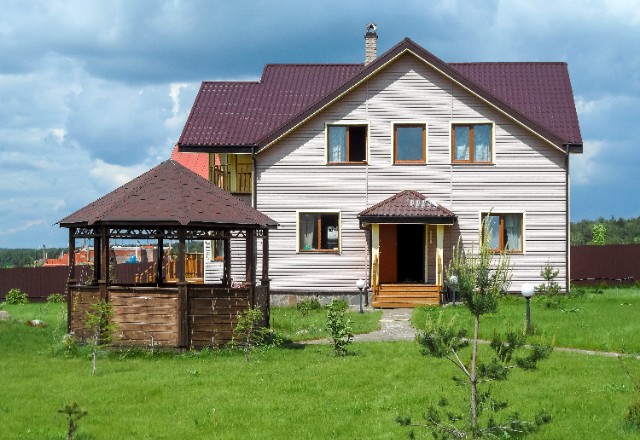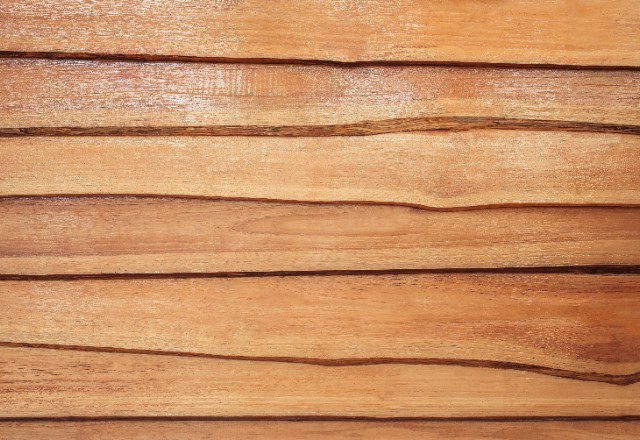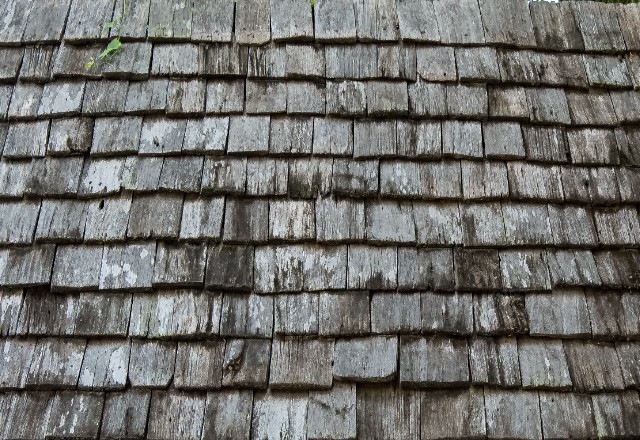Making the decision to upgrade your home’s siding is a big one. Not only does it impact the overall look of your home, but it also affects its protection from the elements and your utility bills. Whether you’re looking for a modern low-maintenance option or something more traditional, there are several types of replacement siding to choose from. Let’s dive in and explore all the benefits that come with replacing your home’s siding.
Disclaimer: The information provided in this article is intended to be general and should not be used as a substitute for professional advice. If you are considering replacing or upgrading your home siding, please consult a qualified contractor before making any decisions. We strongly recommend contacting us at Advance Roofing LLC for expert consultation and installation services. We have been proudly serving the Spokane, WA area for many years with the highest standard of quality roofing solutions.
What is Siding?
Siding is an exterior cladding material that is installed on the sides of a home or building. It acts as a protective barrier from the elements and helps to insulate the structure from heat, cold, and moisture. Siding also adds aesthetic value by providing a visual appeal to your home’s exterior. There are many types of siding materials available, including wood, vinyl, aluminum, fiber cement, stucco and stone. Each offers different levels of durability, maintenance requirements and cost effectiveness. Depending on your budget and design preferences, you can choose the right siding for your home’s exterior needs.
Siding is a great way to upgrade the exterior of your home, protecting it from the elements and adding aesthetic value. With so many options available, finding the perfect fit for your home’s needs can be easy. Now that you know more about siding, why not explore its benefits further? Learn how replacing your home’s siding could improve its function and look in the next section!
Advantages of replacing the siding on your home
Replacing your home’s siding can offer numerous benefits to any homeowner. For starters, replacing your siding will improve the overall look of your home’s exterior, giving it a fresh new appearance that is sure to turn heads. It can also help increase the resale value of your home and even improve its energy efficiency by providing better insulation from the elements. Replacing your siding can also extend the lifespan of your home’s structure, as newer materials are more likely to be longer-lasting and durable than older ones. Finally, replacing your siding can also help protect against weather damage and reduce maintenance costs in the long run. With so many benefits associated with replacing your home’s siding, why not see how it could improve both the look and protection of your property?
Types of Siding
When it comes to the types of siding available for your home, there are many options to choose from. Vinyl is a popular choice due to its affordability and ease of installation, while cedar shake offers a classic look that many homeowners prefer. Fiber cement is another great option because of its durability and low maintenance requirements. Brick is also an attractive option that can increase the value of your home, while stucco provides an elegant Mediterranean-style finish. Ultimately, the type of siding you choose will depend on your personal taste and budget. Whichever type you decide on, it’s important to make sure that you get it installed by a professional who has experience with the specific material so that it lasts for years to come!
No matter which type of siding you choose for your home, it’s important to select a material that matches your style and budget. With the large variety of options available, you’re sure to find something perfect for your needs. Get ready to explore one popular option – next up is vinyl siding!
Vinyl Siding
Vinyl siding is a commonly chosen option by homeowners because of its affordability and easy installation process. It is composed of polyvinyl chloride (PVC) which gives it resistance to moisture, pests, and extreme temperatures. It also requires little maintenance compared to other types of siding and can be found in a wide range of colors and styles. Vinyl siding can be installed quickly, making it an ideal option for those who don’t want to invest too much time into their home’s exterior. Additionally, this type of siding helps reduce energy costs by providing insulation that keeps your home cooler in the summer and warmer in the winter. With its cost-effective price point and low maintenance requirements, vinyl siding can be a great upgrade for any home!

James Hardie Fiber Cement Siding
James Hardie Fiber Cement siding is the perfect solution for homeowners looking to upgrade the look and protection of their home. This type of siding is made from a combination of cement, sand, and cellulose fibers, making it resistant to moisture, pests, fire, and extreme temperatures. Additionally, fiber cement siding is available in various colors and styles, allowing you to customize your home’s exterior. Plus, unlike vinyl siding it does not expand or contract with temperature changes. With its superior durability and low maintenance requirements, James Hardie Fiber Cement Siding can help protect your home for years to come!
Aluminum Siding
Aluminum Siding is a practical and attractive solution for homeowners looking to upgrade their home’s protection and aesthetic. This type of siding is lightweight, yet durable enough to withstand harsh weather conditions, pests, and fire. Plus, it’s easy to install and maintain. Aluminum siding also comes in a wide variety of colors and styles, so you can easily match your home’s existing architecture or create a completely new look. Additionally, aluminum siding is extremely energy efficient as it reflects the sun’s heat away from your home, helping you save on monthly energy bills. With its affordability and low-maintenance needs, aluminum siding can be an excellent choice for protecting your home for years to come!
Wood Lap Siding
Wood lap siding is an excellent option for homeowners looking to enhance their home’s traditional look. This type of siding is made from planks of wood, typically cedar or pine, and provides a natural, rustic charm that can instantly boost your home’s curb appeal. Since it’s made from wood, wood lap siding is highly durable and able to withstand harsh weather conditions and pests. Plus, its timeless look offers a variety of options when it comes to paint colors and finishes. Wood lap siding also adds an extra layer of insulation to your home, providing protection against both cold and hot temperatures. With its classic beauty and excellent longevity, wood lap siding is a great choice for anyone wanting to upgrade their home!

Modern Low-Maintenance Options
Modern siding options have come a long way in recent years, offering homeowners the chance to upgrade their homes with low-maintenance solutions. Vinyl siding is one of the most popular modern siding options on the market and is available in a variety of colors and styles. Vinyl is incredibly durable, making it resistant to both weather conditions and pests. It’s also incredibly easy to maintain—all you need to do is give it a simple wash every now and then! Plus, since vinyl doesn’t require painting, you can save time and money. Another excellent low-maintenance option is fiber cement siding. Fiber cement has the look of wood but without the upkeep, as it’s highly resistant to rot, insects, fire, and even extreme temperatures. With its durability and classic style, fiber cement siding is sure to make your home look great for years to come!
Considerations When Choosing a Type of Replacement Siding
When selecting replacement siding for your home, there are a few important considerations to keep in mind. First and foremost, you’ll want to evaluate the climate of your geographic area. Different types of siding are more suitable for different climates— vinyl siding stands up better against extreme temperatures than wood, for example. You’ll also want to consider the look and feel of the material you choose. Vinyl offers a modern look with low-maintenance upkeep, while fiber cement has a classic style that is highly resistant to rot and insects. Finally, don’t forget about budget—siding installation can be expensive so make sure you research all your options before making a decision! With these factors in mind, you’ll be sure to find the perfect type of replacement siding for your home!
Replacing the siding of your home is an important decision that requires careful consideration. With the right material selection, you can enjoy a beautiful exterior with enhanced energy efficiency and reduced utility bills!
Energy Efficiency and Utility Bills
Energy efficiency and lower utility bills are two of the biggest benefits that come with replacing your home’s siding. By opting for a material such as vinyl or fiber cement, you can enjoy enhanced insulation that helps keep your home at a comfortable temperature year-round. This means you’ll use less energy to maintain the desired temperature in your home, resulting in reduced utility bills—a great bonus for any homeowner! Additionally, many of these materials have added features like UV protection or waterproofing that can help keep your home better protected from the elements. With so many advantages to choosing replacement siding, it’s easy to understand why this is a popular choice for homeowners looking to upgrade their property!

Curb Appeal and Aesthetics
Replacing your home’s siding is an easy way to give it a much-needed facelift and boost its curb appeal. Whether you opt for vinyl, fiber cement, or another material, there are plenty of colors and textures to choose from that can match your home’s existing style. If you’re looking for something truly unique, some materials even come with features like simulated cedar shakes or stone veneers that will really make your property stand out. And regardless of which option you go with, you can be sure that the new siding will make your home look beautiful and inviting—a great bonus for anyone who takes pride in their property!

Proper Installation and Maintenance Requirements
Proper installation and maintenance of replacement siding is essential to ensuring its durability and longevity. To start, be sure to hire a professional installer who has experience with the type of siding you’ve chosen. They’ll be able to advise you on any additional steps that may need to be taken for your specific home. Once installed, it’s important to keep an eye out for any loose panels or other signs of deterioration and address them promptly. Regular cleaning with a mild detergent will also help keep the siding looking its best for years to come. Lastly, check the manufacturer’s instructions for any recommended maintenance intervals—following their advice will help guarantee that your new siding stays in great shape!
Extreme Weather Conditions
When it comes to extreme weather conditions, your home’s siding is always at risk. High winds and hail can damage any type of siding, but especially those that aren’t properly installed or maintained. To ensure the best protection for your home in case of extreme weather conditions, consider investing in high-quality replacement siding. It’s designed to withstand the harshest elements and provide superior protection from wind, rain, snow, and hail. Plus, it adds a fresh look that will stand up to time and make your home look great for years to come. With proper installation and regular maintenance, you can have peace of mind knowing that your home is safe from whatever Mother Nature throws its way!
Cost vs. Benefit Analysis for Each Option
When it comes to choosing the right siding for your home, it’s important to consider cost vs. benefit analysis for each option. Vinyl siding is often the most cost-effective choice, but if you’re looking for something more durable and aesthetically pleasing, you may want to consider higher-end options such as fiber cement or composite wood. Fiber cement is more expensive than vinyl and will require professional installation, but its superior durability and classic look make it worth the investment in the long run. Composite wood provides a unique look that many find appealing, but again, is more costly than other options. Ultimately, the decision of which type of siding to choose should be based on a careful cost vs. benefit analysis that considers factors such as expected longevity, ease of maintenance, and aesthetic appeal.
Signs You Need Replacement Siding
Are you noticing that your home’s siding is looking a bit worn down? If so, it might be time to consider replacing it. Here are some signs that your home is in need of replacement siding:
- Cracks or other damage: If you notice cracks, holes, or other damage to the siding on your home, this could be an indication that it needs to be replaced.
- Warping or buckling: Warping or buckling of the siding can occur from exposure to extreme weather conditions and can weaken its structural integrity.
- Fading: If you notice that your siding is fading in color, this could also indicate that it needs to be replaced.
- Missing pieces: Missing pieces of siding can create openings for moisture and pests to enter into your home, making replacement necessary.
If you’re noticing any of these signs with your current siding, it’s probably time to start researching options for replacement. Upgrading your siding not only helps protect your home from the elements but also adds value and curb appeal!
Replacing your home’s siding is a great way to not only protect your home but also add value and curb appeal. Don’t wait any longer – explore the pros and cons of replacing your home’s siding to decide if it’s right for you!

Pros and Cons of Replacing Your Home’s Siding
Replacing your home’s siding can be an exciting way to upgrade the look and protection of your home. However, before you make any decisions, it’s important to consider the pros and cons of replacing your siding.
On the plus side, replacing your siding can add value to your home and help protect it from the elements. Additionally, new siding can give your home a modern look that will grab the attention of potential buyers if you decide to sell in the future.
However, replacing your siding isn’t without its drawbacks. Replacing siding is a labor intensive job that requires time and money – factors which may not always be feasible for homeowners. Additionally, some types of material used for siding require more maintenance than others, so you’ll want to research which material is best for you before making a decision.
Ultimately, deciding whether or not to replace your home’s siding comes down to personal preference and budget considerations. Weighing these pros and cons can help you make an informed decision about what’s best for you and your home!
Replacing your home’s siding can be a great choice to add value and protection, but it’s important to consider the pros and cons before making a final decision. Are you prepared to take on a major project? Next, we’ll look at how to know if it’s time for replacement siding.

Preparing for a Major Project: How to Know if it’s Time for Replacement Siding
Preparing for a major project like replacing your home’s siding can be stressful and time consuming. But, how do you know if it’s time to replace your siding? Here are some signs that it might be time to consider replacement siding:
- Cracking or warping of the current siding – this could be an indication of water damage or age and is a sign that replacement is necessary.
- Faded color or discoloration – if your current siding has lost its luster, it may be time for a modern upgrade!
- Gaps between panels – gaps can let in moisture, leading to more serious problems down the line.
- Signs of insect damage – wood-boring insects can cause major structural issues if they’re not dealt with properly.
If you’re noticing any of these signs, it may be time to consider replacing your home’s siding. You’ll want to make sure you have a professional inspect your home before making any decisions so that you know exactly what kind of work needs to be done. This will help ensure that your new siding lasts for many years and looks great!
Replacing your home’s siding can be a big undertaking, but it can also be a great way to upgrade the look of your home and prevent any further damage. Before you get started with the project, make sure you have a plan in place to ensure success! Next up: Steps to Take Prior to Installing Replacement Siding.
Steps to Take Prior to Installing Replacement Siding
Once you’ve decided to install replacement siding, it’s important to take the proper steps before beginning the project. Here are some tips for getting started:
- Set a budget – Before you get started, decide how much money you want to spend on your new siding. This will help keep you from overspending and ensure that your new siding looks great!
- Measure your home – Since different types of siding come in different sizes, it is important to measure your home accurately before purchasing any materials.
- Research materials – There are many types of replacement siding available on the market today, so take the time to research which type would be best for your needs and budget.
- Choose a contractor – Now that you know what kind of material and how much money you want to spend, it’s time to find a contractor who can do the job right. Make sure they have experience with installing replacement siding and references from previous clients.
- Prepare your yard – Before any work can begin, make sure that all plants and landscaping around your home are removed or covered up so they don’t get damaged during installation.
Taking these steps prior to installing replacement siding will help ensure that you get the most out of your investment and have a beautiful new look for years to come!
Replacement siding is a great way to update your home and add value. With the right materials, budget, and contractor, you can have beautiful new siding that will last for years to come. Now let’s move on to the conclusion where we’ll discuss how to make sure your project is successful.
Conclusion
The conclusion of your home siding installation project is just as important as the steps prior. To ensure that everything goes smoothly, it’s important to follow up with your contractor and make sure that all the work was done according to your specifications. Be sure to inspect the finished product thoroughly and be sure that everything looks great before making a final payment.
It’s also a good idea to keep track of any warranties or guarantees associated with the materials you purchased, as well as any maintenance instructions provided by the manufacturer. Following these simple steps will help you get the most out of your replacement siding and protect your investment for years to come!



 509-201-4190
509-201-4190
